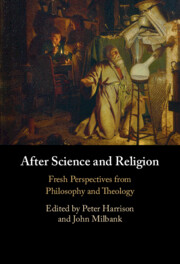Refine search
Actions for selected content:
12661 results in History of science
Part II - Beyond ‘Science and Religion’
-
- Book:
- After Science and Religion
- Published online:
- 05 May 2022
- Print publication:
- 19 May 2022, pp 59-216
-
- Chapter
- Export citation
Conclusion
- from Part IV - Before Science and Religion
-
-
- Book:
- After Science and Religion
- Published online:
- 05 May 2022
- Print publication:
- 19 May 2022, pp 316-324
-
- Chapter
- Export citation
Chapter 10 - The Problem of the Problem of Scientism
- from Part III - Philosophical Problems with ‘Science’ and ‘Religion’
-
-
- Book:
- After Science and Religion
- Published online:
- 05 May 2022
- Print publication:
- 19 May 2022, pp 232-256
-
- Chapter
- Export citation
Chapter 6 - Questioning the Science and Religion Question
- from Part II - Beyond ‘Science and Religion’
-
-
- Book:
- After Science and Religion
- Published online:
- 05 May 2022
- Print publication:
- 19 May 2022, pp 155-170
-
- Chapter
- Export citation
Part IV - Before Science and Religion
-
- Book:
- After Science and Religion
- Published online:
- 05 May 2022
- Print publication:
- 19 May 2022, pp 257-324
-
- Chapter
- Export citation
Chapter 4 - Religion, Science and Magic
- from Part II - Beyond ‘Science and Religion’
-
-
- Book:
- After Science and Religion
- Published online:
- 05 May 2022
- Print publication:
- 19 May 2022, pp 75-143
-
- Chapter
- Export citation
Chapter 12 - Physics as Spiritual Exercise
- from Part IV - Before Science and Religion
-
-
- Book:
- After Science and Religion
- Published online:
- 05 May 2022
- Print publication:
- 19 May 2022, pp 282-298
-
- Chapter
- Export citation
Chapter 13 - Making Art
- from Part IV - Before Science and Religion
-
-
- Book:
- After Science and Religion
- Published online:
- 05 May 2022
- Print publication:
- 19 May 2022, pp 299-315
-
- Chapter
- Export citation
Introduction
-
-
- Book:
- After Science and Religion
- Published online:
- 05 May 2022
- Print publication:
- 19 May 2022, pp 1-12
-
- Chapter
- Export citation
Chapter 7 - Truth, Science and Re-enchantment
- from Part II - Beyond ‘Science and Religion’
-
-
- Book:
- After Science and Religion
- Published online:
- 05 May 2022
- Print publication:
- 19 May 2022, pp 171-200
-
- Chapter
- Export citation

After Science and Religion
- Fresh Perspectives from Philosophy and Theology
-
- Published online:
- 05 May 2022
- Print publication:
- 19 May 2022
List of Figures and Table
-
- Book:
- Being Human during COVID-19
- Published by:
- Bristol University Press
- Published online:
- 13 October 2022
- Print publication:
- 26 April 2022, pp vi-vi
-
- Chapter
- Export citation
Part I - Knowing Humans
-
- Book:
- Being Human during COVID-19
- Published by:
- Bristol University Press
- Published online:
- 13 October 2022
- Print publication:
- 26 April 2022, pp 11-12
-
- Chapter
- Export citation
Index
-
- Book:
- Being Human during COVID-19
- Published by:
- Bristol University Press
- Published online:
- 13 October 2022
- Print publication:
- 26 April 2022, pp 156-163
-
- Chapter
- Export citation
Conclusion: Thinking about ‘the Human’ during COVID-19 Times - Conclusion
-
-
- Book:
- Being Human during COVID-19
- Published by:
- Bristol University Press
- Published online:
- 13 October 2022
- Print publication:
- 26 April 2022, pp 147-155
-
- Chapter
- Export citation
Frontmatter
-
- Book:
- Being Human during COVID-19
- Published by:
- Bristol University Press
- Published online:
- 13 October 2022
- Print publication:
- 26 April 2022, pp i-ii
-
- Chapter
- Export citation
sixteen - Inclusive Education in the Post-COVID-19 World
-
-
- Book:
- Being Human during COVID-19
- Published by:
- Bristol University Press
- Published online:
- 13 October 2022
- Print publication:
- 26 April 2022, pp 132-139
-
- Chapter
- Export citation
ten - Genomic Medicine and the Remaking of Human Health
-
-
- Book:
- Being Human during COVID-19
- Published by:
- Bristol University Press
- Published online:
- 13 October 2022
- Print publication:
- 26 April 2022, pp 85-91
-
- Chapter
- Export citation
five - Managing Pandemic Risk in an Interconnected World: What Planning a Wedding Shows about Early Responses to the COVID-19 Outbreak
-
-
- Book:
- Being Human during COVID-19
- Published by:
- Bristol University Press
- Published online:
- 13 October 2022
- Print publication:
- 26 April 2022, pp 44-50
-
- Chapter
- Export citation
one - Making Models into Public Objects
-
-
- Book:
- Being Human during COVID-19
- Published by:
- Bristol University Press
- Published online:
- 13 October 2022
- Print publication:
- 26 April 2022, pp 13-19
-
- Chapter
- Export citation
